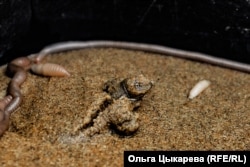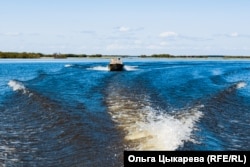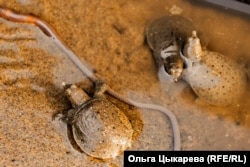Schoolchildren from the village of Innokentievka in the Nanai district of Russia's Khabarovsk region spent their summer holidays in an unusual way, saving turtles from forest predators and annual floods. The project is called Save the Far Eastern Turtle.
The endangered turtle, called trionyx, also known as Chinese softshell turtle, is becoming less and less common in its habitat, the Russian Far East. Trionyx is a softshell turtle, which means its shell doesn't harden, but is leathery instead.
The soft shell makes these turtles almost defenseless against predators -- foxes and raccoon dogs, which love to eat adult reptiles and their eggs.
For the second year now, schoolchildren from Innokentievka went on rescue expeditions during their summer break. Children collect clutches of eggs, nurture them in an incubator, and take care of the baby turtles.
The main event is the release of the turtles into the water, which happens at the end of summer. Before release, the hatchlings are counted.
Placed in black containers in the wet river sand, the reptiles are not immediately visible. But as soon as the containers are taken out in the sun, turtles emerge from the bumps in the sand.
One of the main habitats of the ancient reptile is Lake Gassi in the Nanai district of Russia's Khabarovsk region. Part of the lake falls within Anyuisky National Park, while another part is surrounded by nearby villages.
"These turtles are very cautious. In winter they go deep to the bottom of the lake and hide in holes," says Rimma Andronova, head of the scientific department of Khabarovsk's Joint Directorate of Nature Reserves and National Parks. "At the same time, we find many clutches -- sometimes it happens that there are hundreds of clutches on a few dozen meters of the sandy shore. But turtles also have a lot of enemies. Raccoon dogs and foxes that have bred in Anyuisky National Park often destroy turtles' nests. Baby turtles can be eaten by birds," she says.
The staff of the nature reserve happily accepts help from the schoolchildren.
"Once we found footprints of both turtles and foxes near the clutch of eggs," says one of the project participants, Polina. "It looks like there was a real fight. As if the fox caught the turtle right during the laying of eggs and the reptile protected itself from the predator."
To scare off predators, gauze dipped in fir oil and vanilla aroma is put in the ground near the turtle's clutch. Foxes do not like pungent odors and so they leave.
However, the main danger for the turtle population is floods, because they simply wash away the clutches of eggs. Water arrives before the babies have hatched and in high water the clutch dies immediately.
"Last year we rescued and released 83 turtles. This year, as soon as the water started to rise, we also went to look for clutches: we already knew the places that are usually flooded. We managed to find five clutches: 28, 25, two of 33, and the largest one of 45 eggs. All of them were placed in an incubator and then we just waited," says Dmitry Krishkevich, a teacher at the Center for Extracurricular Activities and head of the Save the Far Eastern Turtle project.
The turtle's nest structure is quite complex. The eggs are laid in a pyramid, with the largest ones at the bottom. After laying the eggs, the female covers them with a protective layer of sand.
"This pyramidal clutch of eggs behaves like a single organism. Turtles hatch almost simultaneously. But the truth is that one hatchling will not be able to break through the thickness of sand, as dense as cement. It turns out that hatching is a big collective work for them," Krishkevich explains.
This year, 147 turtles were born out of 166 eggs collected. Now it's necessary to find a place to release them into the water. It is not so easy because the sandy beaches inhabited by reptiles are now flooded. Rescuers set out on motorboats along Lake Gassi in search of a suitable shore.
But the banks of the lake are now underwater almost to tree-level. Only 20 minutes later, having driven away from the nearby village of Dubovy Mys, the rescuers find a place within Anyuisky National Park.
"Let's dock here," says Rimma Andronova, looking at a small piece of flat land. "Here they can settle. Interestingly, they know by themselves where to go. Maybe, of course, some turtle will run in the wrong direction. But it's no problem, we will fix that."
"They survived the dinosaurs, so they know something", Krishkevich adds.
Young ecologists clear the dead wood to open the way for the turtles to the water. Released hatchlings are counted so as not to miss anyone.
"We had one 'partisan' last year," Kishkevich recalls. "Very cleverly hiding! We were already going back, rinsing the container from the sand -- and it was lurking there in the corner! So now we are counting them all."
Each baby turtle is no more than 5 centimeters in diameter. The children carefully take out each saved hatchling and put it on the ground. And the majority of turtles actually go straight into the water, digging into the grass and silt near the shore. So by the end of the release, no turtle is visible. Only one turtle had to be put three times on the right path -- he kept trying to escape into the forest.
"Next year I will definitely do this again," says one schoolgirl, Ira. "We can't stop here, we need to continue to replenish the population. We released them and, to be honest, we are very proud of ourselves. We are real lifesavers!"
"Exactly, rescuers!" adds another girl, Katya. "This is a big deal. Otherwise, because of the flood, they would not hatch at all."
The schoolchildren have already met last year's "turtle children" this year. And the largest turtle footprint found was about 30 centimeters, which is already an adult, weighing about 4-5 kilograms.
"We hope that our project will be supported by WWF and we will be able to install camera traps. Because when we check turtles at their places each day, they begin to bypass such visited places. And so we would know when they start to lay eggs, we could track them by using a camera trap and not bother them again," Krishkevich says.
The Far Eastern turtle can also be found in China. There, the turtles are bred in large quantities. There are even special turtle farms, whose "products" go to restaurants. Wild Far Eastern turtles are also in demand among Chinese gourmets.
"I saw these farms," Krishkevich says. "It's a huge swamp, where 800 tons of turtles are hatched per year. Now the smugglers are trying to buy our wild trionyx. Give them free rein and they will eat them all."
Meanwhile, the children laid out the last "home" sand from the turtle baths on the ground. And a couple of the reptiles immediately decided to return to their home sand.
"At first, our turtles were afraid of people. But now they got used to both me and the children. But it's alright, they will get comfortable in the wild. In the evening they will crawl out on their sand, warm themselves, and here they will have flies and mosquitoes to eat. And next year we will definitely find them,", Krishkevich says as the ecologists say good-bye to their "offspring."




















